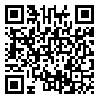Fri, Nov 28, 2025
[Archive]
Volume 8, Issue 3 (September 2012)
IJEEE 2012, 8(3): 195-205 |
Back to browse issues page
Download citation:
BibTeX | RIS | EndNote | Medlars | ProCite | Reference Manager | RefWorks
Send citation to:



BibTeX | RIS | EndNote | Medlars | ProCite | Reference Manager | RefWorks
Send citation to:
Jamali Rad H, Abolhassani B, Abdizadeh M. Mathematical Analysis of Optimal Tracking Interval Management for Power Efficient Target Tracking Wireless Sensor Networks. IJEEE 2012; 8 (3) :195-205
URL: http://ijeee.iust.ac.ir/article-1-381-en.html
URL: http://ijeee.iust.ac.ir/article-1-381-en.html
Abstract: (7790 Views)
In this paper, we study the problem of power efficient tracking interval management for distributed target tracking wireless sensor networks (WSNs). We first analyze the performance of a distributed target tracking network with one moving object, using a quantitative mathematical analysis. We show that previously proposed algorithms are efficient only for constant average velocity objects however, they do not ensure an optimal performance for moving objects with acceleration. Towards an optimal performance, first, we derive a mathematical equation for the estimation of the minimal achievable power consumption by an optimal adaptive tracking interval management algorithm. This can be used as a benchmark for energy efficiency of these adaptive algorithms. Second, we describe our recently proposed energy efficient blind adaptive time interval management algorithm called Adaptive Hill Climbing (AHC) in more detail and explain how it tries to get closer to the derived optimal performance. Finally, we provide a comprehensive performance evaluation for the recent similar adaptive time interval management algorithms using computer simulations. The simulation results show that using the AHC algorithm, the network has a very good performance with the added advantage of getting 9 % closer to the calculated minimal achievable power consumption compared with that of the best previously proposed energy efficient adaptive time interval management algorithm.
Keywords: Wireless Sensor Networks (WSNs) , Distributed Target Tracking , Tracking Interval , Network Lifetime , Power Efficiency
Type of Study: Research Paper |
Subject:
Ad-Hoc Communications
Received: 2011/03/14 | Revised: 2012/09/19 | Accepted: 2012/09/19
Received: 2011/03/14 | Revised: 2012/09/19 | Accepted: 2012/09/19
| Rights and permissions | |
 |
This work is licensed under a Creative Commons Attribution-NonCommercial 4.0 International License. |







